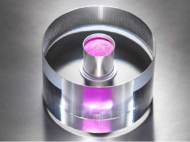A step closer to room-temperature operating MASERs
 Although they were invented before lasers, MASERs (Microwave Amplification by Stimulated Emission of Radiation) didn’t quite find their use as lasers since they required specific conditions to operate. Scientists from the National Physical Laboratory (NPL) and Imperial College London managed to develop a solid-state MASER able to operate at room temperature, thus enabling its more widespread adoption by industry.
Although they were invented before lasers, MASERs (Microwave Amplification by Stimulated Emission of Radiation) didn’t quite find their use as lasers since they required specific conditions to operate. Scientists from the National Physical Laboratory (NPL) and Imperial College London managed to develop a solid-state MASER able to operate at room temperature, thus enabling its more widespread adoption by industry.
Conventional MASER technology delivers an amplified beam of microwaves. These microwaves are concentrated in a process known as masing, where a crystal (such as ruby) amplifies the microwaves. Devices based on this process were developed more than 50 years ago, but they required specific operational conditions with large magnets and extremely low pressures, supplied by special vacuum chambers and pumps, or freezing conditions at temperatures close to absolute zero (-273.15 °C), supplied by special refrigerators.
The team from NPL and Imperial managed to achieve masing in a solid-state device which operates at room temperature with no applied magnetic field. This breakthrough means that the cost to manufacture and operate MASERs could be dramatically reduced, which could lead to them becoming as widely used as LASER technology.
“For half a century the MASER has been the forgotten, inconvenient cousin of the LASER. Our design breakthrough will enable MASERs to be used by industry and consumers”, said Dr Mark Oxborrow, co-author of the study at NPL.
Instead using ruby, the team discovered that a completely different type of crystal, namely p-terphenyl doped with pentacene, can replicate the same masing process at room temperature. As a curious twist, the pentacene dopant turns the otherwise colorless p-terphenyl crystal to resemble a ruby and coloring it to an intense reddish pink color.
“When LASERs were invented no one quite knew exactly how they would be used and yet, the technology flourished to the point that LASERs have now become ubiquitous in our everyday lives”, said Professor Neil Alford, co-author and Head of the Department of Materials at Imperial College London. “We’ve still got a long way to go before the MASER reaches that level, but our breakthrough does mean that this technology can literally come out of the cold and start becoming more useful.”
Since their first device can work in pulsed mode for fractions of a second at a time, the researchers are looking for ways to enable continuous work of a MASER. They also aim to get it to operate over a wider range of microwave frequencies, rather than currently used narrow bandwidth, in order to make the technology more useful in different fields of science and industry.
Among other long term goals, the team plans to identify other materials that could be used in the masing process at room temperature while consuming less power than pentacene-doped p-terphenyl. They also plan to devise new designs that could make enable creation of smaller and more portable MASER systems.
Once perfected, room-temperature MASERs could be used to make more precise and sensitive medical instruments for scanning patients, improved chemical sensors for remotely detecting explosives, lower-noise read-out mechanisms for quantum computers and better radio telescopes.
For more information, read the paper published in journal Nature: “Room-temperature solid-state maser”.









Hello,